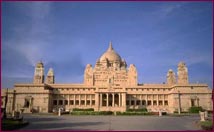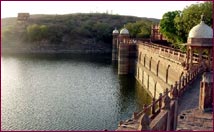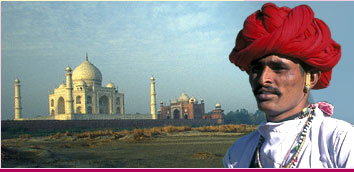Set at the edge of the Thar desert, the imperial city of Jodhpur echoes with tales of antiquity in the emptiness of the desert. Once the capital of the Marwar state, it was founded in 1459 A.D. by Rao Jodha-chief of the Rathore clan of Rajputs who claimed to be descendants of Rama - the epic hero of the Ramayana. The massive 15th century A.D. Mehrangarh Fort looms on the top of a rocky hill, soaring 125 Mts. Above the plains. The city is encompassed by a high wall -10 km long with 8 gates and innumerable bastions. A major trade centre of the 16th century A.D. the fortress-city of Jodhpur is now the second largest city of Rajasthan.
Places to see
- Mehrangarh Fort
Situated on a steep hill, Mehrangarh Fort is one of the largest forts in India. The fort has been a witness to the splendour of a bygone era. The beauty and the grandeur of numerous palaces in the fort narrates a saga of hard sandstones yielding to the chisels of skilled Jodhpuri sculptures. To enter the Mehrangarh fort, seven gates have to be crossed. Some of these gates still bear marks of many a siege that this fort has withstood. Its very hard to imagine how any invader even thought of conquering this fort, which at places has 17 feet thick and 68 feet high walls. The Mehrangarh Fort encloses many palaces, which are known for their intricate carvings and sprawling courtyards. Moti Mahal or the Pearl Palace has a delicately carved stone screen and treasures the Sringar Chowki, royal throne of Jodhpur. Umaid Villas displays the Rajput miniature paintings and Ajit Villas exhibits musical instruments and the royal costumes. Both these villas are joined by a beautiful mirror room. - Umaid Bhawan
 A
subtle blend of Edwardian and Rajputana architectural styles,
the Umaid Bhawan Palace was christened after its builder,
Maharaja Umaid Singhji. Tour the Umaid Bhawan Palace that is the
world's grandest royal residences ever built with Indian
Horizons. The Umaid Bhawan Palace in Jodhpur took shape as
killed artisans put together blocks of gleaming yellow sandstone
atop the Chittar Hill in Jodhpur, Rajasthan, India. The entire
Umaid Bhawan Palace in Jodhpur is segregated into three
sections, the Museum, the heritage hotel and the private wing
that is still occupied by the royal family of Jodhpur,
Rajasthan, India.
A
subtle blend of Edwardian and Rajputana architectural styles,
the Umaid Bhawan Palace was christened after its builder,
Maharaja Umaid Singhji. Tour the Umaid Bhawan Palace that is the
world's grandest royal residences ever built with Indian
Horizons. The Umaid Bhawan Palace in Jodhpur took shape as
killed artisans put together blocks of gleaming yellow sandstone
atop the Chittar Hill in Jodhpur, Rajasthan, India. The entire
Umaid Bhawan Palace in Jodhpur is segregated into three
sections, the Museum, the heritage hotel and the private wing
that is still occupied by the royal family of Jodhpur,
Rajasthan, India. - Jaswant Thada
 The
Jaswant Thada is a flawlessly executed piece of Rajputana
architecture that enchants you with its poignant appeal on your
tours to Jodhpur tourist attractions with Indian Horizons. Un
paralled in grace, the Jaswant Thada is a royal cenotaph that
was constructed by Maharaja Sardar Singh to honor the memory of
his courageous father, Maharaja Jaswant Singh II. The main
cenotaph that is dedicated to Maharaja Jaswant Singhji is
designed like an exquisite piece of jewelry, magnified out of
proportion. The white marble Jaswant Thada looks like a lovely
temple that entices you with its pavilions, domes and delicate
looking pillars. Feast your eyes on the profusion of marble
latticework that adorns the entire Jaswant Thada. See true to
life portraits of Rathore warriors who ruled Jodhpur, admire
colorful dedications to the maharanis and concubines of Maharaja
Jaswant Singhji who committed Sati on the pyre of the deceased
ruler.
The
Jaswant Thada is a flawlessly executed piece of Rajputana
architecture that enchants you with its poignant appeal on your
tours to Jodhpur tourist attractions with Indian Horizons. Un
paralled in grace, the Jaswant Thada is a royal cenotaph that
was constructed by Maharaja Sardar Singh to honor the memory of
his courageous father, Maharaja Jaswant Singh II. The main
cenotaph that is dedicated to Maharaja Jaswant Singhji is
designed like an exquisite piece of jewelry, magnified out of
proportion. The white marble Jaswant Thada looks like a lovely
temple that entices you with its pavilions, domes and delicate
looking pillars. Feast your eyes on the profusion of marble
latticework that adorns the entire Jaswant Thada. See true to
life portraits of Rathore warriors who ruled Jodhpur, admire
colorful dedications to the maharanis and concubines of Maharaja
Jaswant Singhji who committed Sati on the pyre of the deceased
ruler. - Balsamand Lake and Palace
 Sprawled
over 300 acres of luxuriant greens in a valley ensconced with
sandstone hills, the Balsamand Lake Palace is located on the
Mandore road that lies at a few kilometers from the main Jodhpur
city. Overlooking the serene Balsamand Lake, the Balsamand
Palace is a 16th century heritage mansion that was constructed
to serve as a summer palace for the Marwar royalty. The
Balsamand Palace served as a tranquil summer getaway for the
kings and queens of Marwar in the medieval era and today it
offers a quiet retreat for those interested in spending a
heritage holiday far from the noise and bustle of the bright
city lights. The Balsamand Lake Palace was converted into a
heritage hotel in 1996 by Maharaja Gaj Singh II.
Sprawled
over 300 acres of luxuriant greens in a valley ensconced with
sandstone hills, the Balsamand Lake Palace is located on the
Mandore road that lies at a few kilometers from the main Jodhpur
city. Overlooking the serene Balsamand Lake, the Balsamand
Palace is a 16th century heritage mansion that was constructed
to serve as a summer palace for the Marwar royalty. The
Balsamand Palace served as a tranquil summer getaway for the
kings and queens of Marwar in the medieval era and today it
offers a quiet retreat for those interested in spending a
heritage holiday far from the noise and bustle of the bright
city lights. The Balsamand Lake Palace was converted into a
heritage hotel in 1996 by Maharaja Gaj Singh II.





